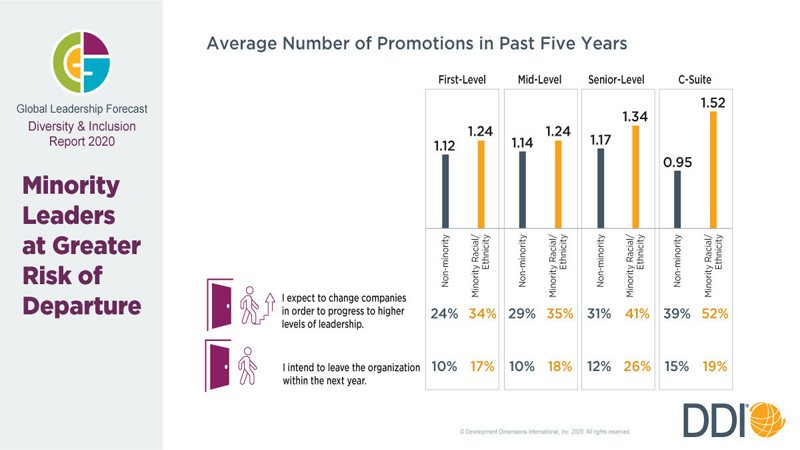New research predicts that there will be an exodus of minority and women leadership talent from the corporate world next year globally, unless employers work harder to retain them.
Senior minority executives plan to leave their current role at double the normal rate of other executives, according to DDI. And this exodus could be coming within the next year, predicts the global consulting firm. “Leaders from minority backgrounds are more likely to feel the need to change companies to progress their career across all leadership levels,” reveals DDI’s Diversity and Inclusion Report 2020.
Also, they are more likely to “plan to leave within the next year”, noted DDI. “This is especially true among senior-level minority leaders, who are more than twice as likely to leave as their non-minority peers.”
HIGH RETENTION RISKS
“While leaders from diverse ethnic and racial backgrounds are finally advancing at a faster rate, our study showed that organisations face high retention risks for these leaders,” stated Stephanie Neal, Director of DDI’s Centre for Analytics and Behavioural Research. “It’s likely that these leaders still face significant barriers as they move up the ladder, which may be why they feel like they have to leave the company to advance. Companies should be paying close attention to how inclusive their culture and talent practices are to ensure they retain these diverse and highly talented leaders.”

The study also found that women are also continuing to struggle to advance. At higher levels of leadership, women indicated an increasing need to switch companies to climb higher in their roles. In fact, 45% of women executives said they would likely need to switch companies to advance, compared to only 32% of male executives.
According to the study, fewer than one in four leaders said their organisation consistently recruits and promotes from a diverse talent pool. Furthermore, only 27% of leaders believe inclusion is a strong part of their organisations’ culture and values.
DIVERSE FIRMS PERFORM BETTER
While organisations are working to build more diverse and inclusive workforces, they are still struggling to retain both minority and women leaders on a global scale. However, the survey found that companies with above-average gender, racial and ethnic diversity had at least 30% of women and 20% of leaders from diverse racial and ethnic backgrounds in leadership roles. These organisations are also eight times more likely to be in the top 10% of organisations for financial performance, DDI noted.
In short, businesses with more diversity in high-potential pools typically see higher financial performance. Firms in the top 10% of financial performance report that women make up 24% of their high-potential pool, and 19% are from diverse racial and ethnic backgrounds, according to the report. Organisations with below average financial performance report less diversity in their high-potential pools. Their pools include only 16% women and 12% from diverse racial and ethnic backgrounds.

INCLUSION IS KEY
Additionally, more than one-third of leaders from companies that qualify as “Best Places to Work” reported that inclusion is a “strong component” of their work culture and value, compared to 20% of leaders from companies without the same label.
“There’s a clear bottom-line benefit to workplace diversity and inclusion, and organisations can only benefit from increasing these efforts,” Neal added. “It’s important that leaders take the time to assess the state of diversity and inclusion in their organisation and employ best practices if they want to realise the benefits of a diverse and inclusive workforce.”
DDI’s survey includes data from 15,787 leaders and 2,102 HR professionals from more than 1,740 organisations across more than 25 industries globally.
Click here to download a copy of the report.







































